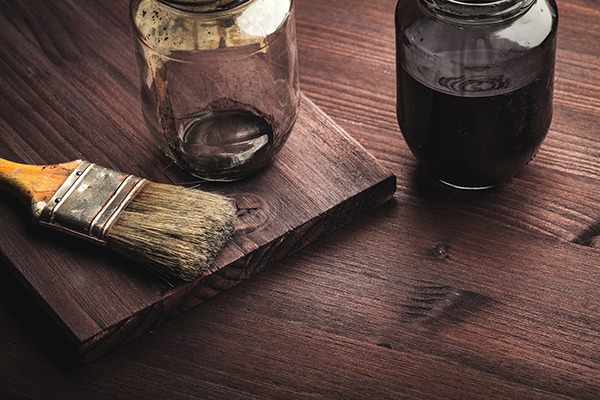Wood is an incredibly versatile building material that presents a unique set of challenges when painting. Issues with moisture, sap and pitch, or knots can cause defects or failure in the applied coating system.
If a semi-transparent stain or a clear finish is to be used to finish, a more exacting process may be required to prepare wood for coating – as opposed to bare wood that is to be finished with a more forgiving, pigmented stain. Follow these steps to ensure a flawless finish that will stand the test of time.

A more exacting process may be required to prepare wood for stain/clear finishes
Remove Water stains/spots and Pencil Marks
Water spots can cause raised grain and surface discoloration if they are not removed before stain application. These must be sanded level with the same grit size (usually 150-grit) that will be used for the final sanding. Finally, pencil marks will show through a stain/clear finish so it is important to sand these out as well.
Glue residue
Many door frames and window sills use wood glue in assembly. Wood glue dries clear, and the residue left behind can be very difficult to see. Stains or clear coatings cannot penetrate glue, so any residue must be removed from to achieve a uniform finish. Sanding is not an effective method for removal; glue residue must be sheared off with a sharp blade. Once the glue is sheared off, sand the surface with 150-grit sandpaper.
Correct Dents/Machine Marks/Compression Marks
Dents, machine marks and compression marks in the wood will cause an uneven finished appearance when using stains because the dented wood fiber is more compact and compressed than the surrounding area. This means that the stain will not be able to penetrate the dented spot as well causing the dents to appear lighter than the surrounding area after application.
To correct this issue, apply warm water to the dented areas. Once the water dries, the fibers of the dented areas will loosen and raise so that the surface can now be sanded smooth.
Filling Holes and Cracks
These should be filled with a wood filler that matches the color of the wood. There are two options for filling holes/cracks if a stain finish is desired:
- Use a cellulose-type filler that accepts a stain. Once it’s sanded, the filler will take the stain.
- Stain the surface, apply the first coat of clear sealer, and match the filler to the color of the stained and sealed surface. This is a higher end solution because the color is matched to the final color of wood after the stain has been applied.
Here’s a great video by the experts at Minwax




